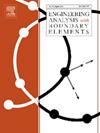Partition-of-unity method based on dual-cover approximation technique for fractured rock mass modeling
IF 4.1
2区 工程技术
Q1 ENGINEERING, MULTIDISCIPLINARY
Engineering Analysis with Boundary Elements
Pub Date : 2025-07-26
DOI:10.1016/j.enganabound.2025.106397
引用次数: 0
Abstract
A partition-of-unity (PU) method based on dual-cover approximation technique (DCAT) is developed for fractured rock mass modeling. In the DCAT, the problem domain is discretized using a structured square mesh independent of discontinuities and boundaries. Sub-blocks generated from the square elements fully cut by discontinuities, as well as the square elements containing crack tips, are termed isolated blocks, while remaining elements are normal blocks. Asymptotic approximations are defined for near-tip isolated blocks based on block cover concept, while the PU approximations are constructed on the remaining blocks based on nodal cover concept. A discontinuous Galerkin (DG) approach is introduced to ensure continuity between isolated blocks and their surrounding blocks. Since the approximations on each block are complete interpolation functions, the DCAT fundamentally eliminates the blending element issues inherent in the conventional PU methods such as the extended/generalized finite element method (XFEM/GFEM) and the numerical manifold method (NMM). By replacing the degrees of freedom of small-area block with those of its adjacent large-area block, the DCAT also provides a straightforward solution to the small-area block trouble. These innovations enable robust simulations of complex fractures with stable computations. Several numerical examples highlight the accuracy, efficiency, and robustness of the present DCAT.
基于双覆盖近似的裂隙岩体建模分割统一方法
提出了一种基于双覆盖近似技术(DCAT)的裂隙岩体模型分割方法。在DCAT中,问题域采用不依赖于不连续点和边界的结构化方形网格进行离散化。由完全被不连续面切割的方形单元以及包含裂纹尖端的方形单元产生的子块称为孤立块,而剩余的单元为正常块。基于块覆盖概念定义了近尖端孤立块的渐近逼近,基于节点覆盖概念构建了剩余块的PU逼近。引入了不连续伽辽金(DG)方法,以确保隔离块与周围块之间的连续性。由于每个块上的逼近都是完整的插值函数,因此DCAT从根本上消除了传统PU方法(如扩展/广义有限元法(XFEM/GFEM)和数值流形法(NMM))固有的混合单元问题。通过将小区域块体的自由度替换为相邻的大区域块体的自由度,DCAT也为小区域块体问题提供了一种直接的解决方案。这些创新使复杂裂缝的模拟具有稳定的计算能力。几个数值算例表明了该方法的准确性、高效性和鲁棒性。
本文章由计算机程序翻译,如有差异,请以英文原文为准。
求助全文
约1分钟内获得全文
求助全文
来源期刊

Engineering Analysis with Boundary Elements
工程技术-工程:综合
CiteScore
5.50
自引率
18.20%
发文量
368
审稿时长
56 days
期刊介绍:
This journal is specifically dedicated to the dissemination of the latest developments of new engineering analysis techniques using boundary elements and other mesh reduction methods.
Boundary element (BEM) and mesh reduction methods (MRM) are very active areas of research with the techniques being applied to solve increasingly complex problems. The journal stresses the importance of these applications as well as their computational aspects, reliability and robustness.
The main criteria for publication will be the originality of the work being reported, its potential usefulness and applications of the methods to new fields.
In addition to regular issues, the journal publishes a series of special issues dealing with specific areas of current research.
The journal has, for many years, provided a channel of communication between academics and industrial researchers working in mesh reduction methods
Fields Covered:
• Boundary Element Methods (BEM)
• Mesh Reduction Methods (MRM)
• Meshless Methods
• Integral Equations
• Applications of BEM/MRM in Engineering
• Numerical Methods related to BEM/MRM
• Computational Techniques
• Combination of Different Methods
• Advanced Formulations.
 求助内容:
求助内容: 应助结果提醒方式:
应助结果提醒方式:


